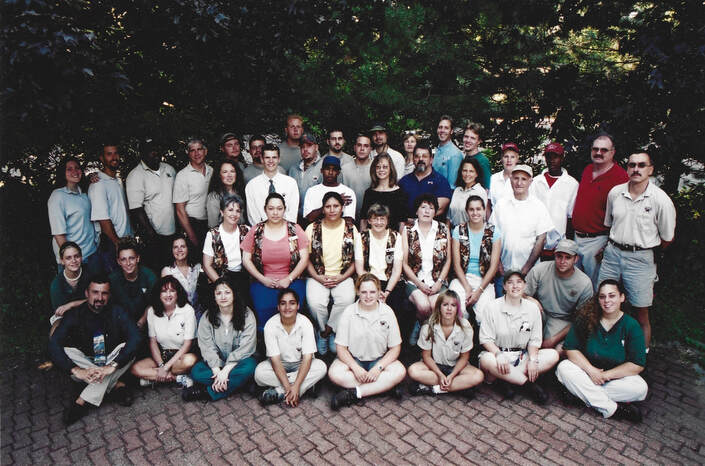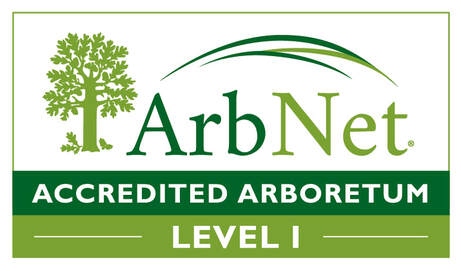In 1922, the Zoo began with a donation of 18 birds and some Barnum circus retirees.
Today, Connecticut’s Beardsley Zoo is a state of the art, accredited, non-profit facility working year-round to care for more than 100 species –including some who are critically endangered, and potentially facing extinction. We inspire stewards of all ages to help ensure a positive future for wildlife and wild places.
In 1922, Connecticut’s Beardsley Zoo opened its doors to the public. Prior to the Zoo’s opening, the city of Bridgeport contracted with architect Frederick Law Olmsted - who designed parts of Central Park - to create a design for Beardsley Park. It wasn’t until 1920 that Parks commissioner Wesley F. Hayes suggested that Bridgeport start a zoo. On October 31, 1959, the Zoo received one of it’s biggest donations. An Indian elephant named Shakuntala, born 1955 in the State forest of Croog, South India, and sent to the United States as a gesture of international friendship. She lived at the Zoo until her death in March of 1978. For years, Connecticut’s Beardsley Zoo had been focused on obtaining as many animals as they possibly could. This all started to change with the hiring of Robert C. McLaughlin as Zoo keeper in 1969. McLaughlin planned to decrease the number of species exhibited at the Zoo in an effort to showcase animals in exhibits reflective of their native habitat and focus more on conservation.
On January 2, 1980, Gregg Dancho was hired as a zookeeper, having been a volunteer for the zoo since 1975 and earning his bachelor of science degree in zoology from Southern Connecticut State University. In 1983, he was named acting Zoo Director at only 25 years of age, and went on to become the official Zoo Director in 1988. Beardsley received it’s first in-term accreditation from the AAZP and Aquariums in 1986. This showed Connecticut’s Beardsley Zoo’s full commitment to professionalism. In 1987, full accreditation was granted.
The carousel museum building, designed by architect Joseph Gambino was completed in 1995. The $375,000 building, funded by the City of Bridgeport, would house a working carousel constructed in 1956 which was originally placed in a mall in Springfield, Massachusetts. The carousel is a replica of one designed by renowned carousel architect Allan Herschell. On May 22, 1997, the Zoo was purchased from the city by The Connecticut Zoological Society. The state agreed to continue giving their support for the zoo, paying salaries of city employees already working at the zoo.
Connecticut’s Beardsley Zoo launched a conservation fund in May 2002 in support of local and global efforts to save wildlife and protect wild places. This fund awards up to $15,000 in funds to worldwide conservation programs. Connecticut’s Beardsley Zoo core education program is the Conservation Discovery Corps (CDC). A science and conservation-based program for high school students ages 14-18. All participants are trained in both zoo and field research. In September of 2014, the Conservation Discovery Corps received top honors in the 2014 AZA Education Award for its outstanding ability to promote conservation knowledge, educate youth, and obtain success in its projects.
On January 2, 1980, Gregg Dancho was hired as a zookeeper, having been a volunteer for the zoo since 1975 and earning his bachelor of science degree in zoology from Southern Connecticut State University. In 1983, he was named acting Zoo Director at only 25 years of age, and went on to become the official Zoo Director in 1988. Beardsley received it’s first in-term accreditation from the AAZP and Aquariums in 1986. This showed Connecticut’s Beardsley Zoo’s full commitment to professionalism. In 1987, full accreditation was granted.
The carousel museum building, designed by architect Joseph Gambino was completed in 1995. The $375,000 building, funded by the City of Bridgeport, would house a working carousel constructed in 1956 which was originally placed in a mall in Springfield, Massachusetts. The carousel is a replica of one designed by renowned carousel architect Allan Herschell. On May 22, 1997, the Zoo was purchased from the city by The Connecticut Zoological Society. The state agreed to continue giving their support for the zoo, paying salaries of city employees already working at the zoo.
Connecticut’s Beardsley Zoo launched a conservation fund in May 2002 in support of local and global efforts to save wildlife and protect wild places. This fund awards up to $15,000 in funds to worldwide conservation programs. Connecticut’s Beardsley Zoo core education program is the Conservation Discovery Corps (CDC). A science and conservation-based program for high school students ages 14-18. All participants are trained in both zoo and field research. In September of 2014, the Conservation Discovery Corps received top honors in the 2014 AZA Education Award for its outstanding ability to promote conservation knowledge, educate youth, and obtain success in its projects.
Today, Connecticut’s Beardsley Zoo is a state of the art, accredited, non-profit facility working year-round to care for more than 100 species –including some who are critically endangered, and potentially facing extinction.
When the Zoo was established 100 years ago, it was a novel experience for people to see, hear, and even smell the animals that were collected here. Now, we provide an educational opportunity for people to understand the world in a way that was largely invisible to them in 1922. When so many of even our youngest guests appear to have the world at their fingertips through computers and smart phones, it becomes even more important to present them with ways to get face-to-face with our world’s wildlife. More than ever before, we need young people to learn first-hand about nature, and the critical need to protect our natural resources: animal, plant, water, air, and soil.
Our goal is to instill a sense of wonder for the wild world, engage guests of all ages with the beauty and power of the animals in our collection, and encourage all of us to do our part to protect the lives of endangered species and endangered places.
Our focus on education, conservation, recreation, and animal welfare is supported by the generosity of community partnerships. We are grateful for the financial contributions, sponsorships, time devoted by our volunteers, corporate giveback days, in-kind donations, and all the ways individuals, businesses and organizations interact with us.
As Connecticut’s only accredited Zoo, we take our role as stewards of wildlife seriously. With nearly 300,000 guests in 2019, we know we’re reaching into the hearts of people in the region. We each have an opportunity— and a responsibility— to carry the heart of the wild world into our little corner of it.
When the Zoo was established 100 years ago, it was a novel experience for people to see, hear, and even smell the animals that were collected here. Now, we provide an educational opportunity for people to understand the world in a way that was largely invisible to them in 1922. When so many of even our youngest guests appear to have the world at their fingertips through computers and smart phones, it becomes even more important to present them with ways to get face-to-face with our world’s wildlife. More than ever before, we need young people to learn first-hand about nature, and the critical need to protect our natural resources: animal, plant, water, air, and soil.
Our goal is to instill a sense of wonder for the wild world, engage guests of all ages with the beauty and power of the animals in our collection, and encourage all of us to do our part to protect the lives of endangered species and endangered places.
Our focus on education, conservation, recreation, and animal welfare is supported by the generosity of community partnerships. We are grateful for the financial contributions, sponsorships, time devoted by our volunteers, corporate giveback days, in-kind donations, and all the ways individuals, businesses and organizations interact with us.
As Connecticut’s only accredited Zoo, we take our role as stewards of wildlife seriously. With nearly 300,000 guests in 2019, we know we’re reaching into the hearts of people in the region. We each have an opportunity— and a responsibility— to carry the heart of the wild world into our little corner of it.
1875: Greenhouse is built.
1878: James Beardsley, a wealthy farmer, donates 100 acres of parkland to what was increasingly an industrial city. His intent was to provide Bridgeport citizens with a way to get away from the city, two- and one-half miles away. He later adds to his gift, making the park approximately 150 acres.
1920: Bridgeport resident P.T. Barnum uses Beardsley Park as a space to exercise his circus animals while overwintering in Bridgeport. Bridgeport Parks Commissioner Wesley F. Hayes starts a campaign for a city zoo to be established in Beardsley Park.
1922: The Zoo opens with eighteen donated birds and some Barnum & Bailey Circus retirees.
1926: The main building in the Zoo is the Greenhouse. Animals are kept outdoors during the warmer months and brought inside the Greenhouse in the winter.
1930s-1940s: The Zoo and its gardens continue to be a popular destination, quietly building its animal collection, and serving as a fun spot for a family outing.
1956: The Zoo has expanded to more than 1,000 animals in its collection, including vervet monkeys, a Skye’s guenon, a Java macaque, spider monkeys, woodchucks, porcupines, and several species of reptiles.
1962: As zoos evolved nationwide, zoos began to serve as conservation spaces for endangered animals. Adopting this philosophy, the Zoo reduces its collection to around 500 animals.
1967: The Zoo’s first volunteers are trained as tour guides for schoolchildren during field trips.
1973: The Zoo opens its Animal Healthcare Clinic.
1976: The Children’s Zoo opens, with more than 2,000 visitors and dignitaries attending the celebration. Today, the Children’s Zoo has been renovated as the New England Farmyard.
1982: First Amur tiger birth at the Zoo.
1983: Gregg Dancho is named Zoo Director.
1985: Zoo Docent program initiated.
1986: The Zoo renovates the hoofed stock area, home to bison, white-tailed deer, and pronghorn antelope.
1986: Greater rhea hatched.
1987: The Zoo is accredited by the Association of Zoos and Aquariums (AZA). The Zoo has continuously held accreditation since then, with a reassessment held every five years.
1989: General Curator position put in place to ensure animal welfare.
1989: Critically Endangered red wolves enter the Zoo for the first time.
1989: The Beardsley Zoo American Association of Zoo Keepers (AAZK) Chapter is created.
1990: Red wolf pups born.
1990: The Zoo 4-H Club is established.
1992: The Bird and Mammal Building is converted to the New World Rainforest Building.
1994: The new Animal Care Center opens, with office and laboratory space, treatment and surgery rooms, a recovery area and animal holding for quarantine purposes.
1995: The Carousel Building opens, with the perimeter of the building showcasing original carousel horses from the Pleasure Beach Amusement Park.
1996: Canada lynx born.
1997: Ownership of the Zoo is transferred from the City of Bridgeport to the Connecticut Zoological Society as a 501c (3) non-profit.
1997: Pronghorn fawn born.
1999: The Zoo opened the Peacock Café with indoor seating for 55 people and outdoor seating for 200.
2001: White-faced saki monkey born.
2002: Pampas Plains opens, showcasing animals from the lowland grasslands of South America.
2003: Rare “Century Plant” blooms in the Zoo’s Greenhouse.
2006: Endangered golden lion tamarin born.
2007: First accredited Zoo to exhibit three male Chacoan peccaries, an endangered species.
2008: “Miracle kitten” born. For only the third time in history, an ocelot kitten was born via artificial insemination technology. He was dubbed the "miracle kitten" because of the long odds of success.
2008: The Zoo welcomed the birth of eight Guinea hog piglets, an important contribution to this species.
2011: First accredited Zoo in the northeast to welcome a Chacoan peccary piglet.
2011: First Yacare caiman hatched.
2013: The Zoo brings an Amur leopard to Connecticut for the first time.
2013: The Zoo welcomes highly endangered Mexican wolves for the first time.
2014: The Zoo receives the AZA Education Award for its outstanding education program.
2014: Four critically endangered red wolf pups are born.
2014: Six Guinea hog piglets are born.
2014: Four Nigerian dwarf goats are born.
2014: Four North American river otter pups are born.
2016: For the first time in Zoo history, a giant anteater pup is born. That pup has been followed by two more, in 2018 and 2021.
2017: Golfodulcean poison dart frogs hatch for the first time at the Zoo.
2017: State-of-the-art Animal Commissary opens.
2017: Rare maned wolf pups born.
2017: Critically endangered Amur tiger cubs born.
2018: Natt Family Red Panda Habitat opens.
2019: Critically endangered Amur leopard cubs born.
2019: Spider monkey habitat opens.
2020: For the second time in Zoo history, a rare 80-year-old “Century” Plant blooms in the Zoo’s Greenhouse.
2020: Zoo closes for three months in response to the Covid-19 pandemic but reopens in June of that year with reduced attendance, social distancing, masking, and cleaning protocols in place.
2022: Zoo celebrates its 100th birthday!
1878: James Beardsley, a wealthy farmer, donates 100 acres of parkland to what was increasingly an industrial city. His intent was to provide Bridgeport citizens with a way to get away from the city, two- and one-half miles away. He later adds to his gift, making the park approximately 150 acres.
1920: Bridgeport resident P.T. Barnum uses Beardsley Park as a space to exercise his circus animals while overwintering in Bridgeport. Bridgeport Parks Commissioner Wesley F. Hayes starts a campaign for a city zoo to be established in Beardsley Park.
1922: The Zoo opens with eighteen donated birds and some Barnum & Bailey Circus retirees.
1926: The main building in the Zoo is the Greenhouse. Animals are kept outdoors during the warmer months and brought inside the Greenhouse in the winter.
1930s-1940s: The Zoo and its gardens continue to be a popular destination, quietly building its animal collection, and serving as a fun spot for a family outing.
1956: The Zoo has expanded to more than 1,000 animals in its collection, including vervet monkeys, a Skye’s guenon, a Java macaque, spider monkeys, woodchucks, porcupines, and several species of reptiles.
1962: As zoos evolved nationwide, zoos began to serve as conservation spaces for endangered animals. Adopting this philosophy, the Zoo reduces its collection to around 500 animals.
1967: The Zoo’s first volunteers are trained as tour guides for schoolchildren during field trips.
1973: The Zoo opens its Animal Healthcare Clinic.
1976: The Children’s Zoo opens, with more than 2,000 visitors and dignitaries attending the celebration. Today, the Children’s Zoo has been renovated as the New England Farmyard.
1982: First Amur tiger birth at the Zoo.
1983: Gregg Dancho is named Zoo Director.
1985: Zoo Docent program initiated.
1986: The Zoo renovates the hoofed stock area, home to bison, white-tailed deer, and pronghorn antelope.
1986: Greater rhea hatched.
1987: The Zoo is accredited by the Association of Zoos and Aquariums (AZA). The Zoo has continuously held accreditation since then, with a reassessment held every five years.
1989: General Curator position put in place to ensure animal welfare.
1989: Critically Endangered red wolves enter the Zoo for the first time.
1989: The Beardsley Zoo American Association of Zoo Keepers (AAZK) Chapter is created.
1990: Red wolf pups born.
1990: The Zoo 4-H Club is established.
1992: The Bird and Mammal Building is converted to the New World Rainforest Building.
1994: The new Animal Care Center opens, with office and laboratory space, treatment and surgery rooms, a recovery area and animal holding for quarantine purposes.
1995: The Carousel Building opens, with the perimeter of the building showcasing original carousel horses from the Pleasure Beach Amusement Park.
1996: Canada lynx born.
1997: Ownership of the Zoo is transferred from the City of Bridgeport to the Connecticut Zoological Society as a 501c (3) non-profit.
1997: Pronghorn fawn born.
1999: The Zoo opened the Peacock Café with indoor seating for 55 people and outdoor seating for 200.
2001: White-faced saki monkey born.
2002: Pampas Plains opens, showcasing animals from the lowland grasslands of South America.
2003: Rare “Century Plant” blooms in the Zoo’s Greenhouse.
2006: Endangered golden lion tamarin born.
2007: First accredited Zoo to exhibit three male Chacoan peccaries, an endangered species.
2008: “Miracle kitten” born. For only the third time in history, an ocelot kitten was born via artificial insemination technology. He was dubbed the "miracle kitten" because of the long odds of success.
2008: The Zoo welcomed the birth of eight Guinea hog piglets, an important contribution to this species.
2011: First accredited Zoo in the northeast to welcome a Chacoan peccary piglet.
2011: First Yacare caiman hatched.
2013: The Zoo brings an Amur leopard to Connecticut for the first time.
2013: The Zoo welcomes highly endangered Mexican wolves for the first time.
2014: The Zoo receives the AZA Education Award for its outstanding education program.
2014: Four critically endangered red wolf pups are born.
2014: Six Guinea hog piglets are born.
2014: Four Nigerian dwarf goats are born.
2014: Four North American river otter pups are born.
2016: For the first time in Zoo history, a giant anteater pup is born. That pup has been followed by two more, in 2018 and 2021.
2017: Golfodulcean poison dart frogs hatch for the first time at the Zoo.
2017: State-of-the-art Animal Commissary opens.
2017: Rare maned wolf pups born.
2017: Critically endangered Amur tiger cubs born.
2018: Natt Family Red Panda Habitat opens.
2019: Critically endangered Amur leopard cubs born.
2019: Spider monkey habitat opens.
2020: For the second time in Zoo history, a rare 80-year-old “Century” Plant blooms in the Zoo’s Greenhouse.
2020: Zoo closes for three months in response to the Covid-19 pandemic but reopens in June of that year with reduced attendance, social distancing, masking, and cleaning protocols in place.
2022: Zoo celebrates its 100th birthday!









